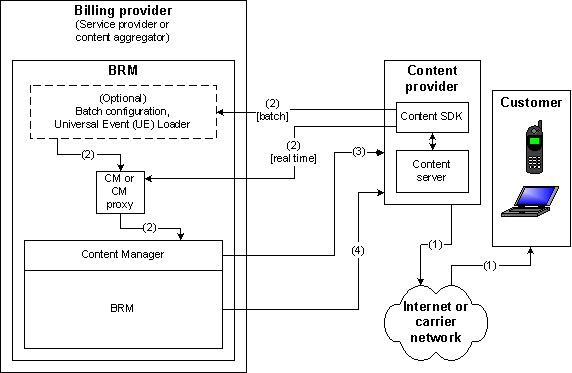1 Understanding Content Manager
This chapter provides an overview of Oracle Communications Billing and Revenue Management (BRM) Content Manager.
Important:
-
Content Manager is an optional component, not part of base BRM.
-
Content providers must upgrade to Content SDK Release 2.0 in order to connect to a billing provider's Content Manager Release 2.0. See "Understanding BRM Content SDK" for information.
Before you read this document, you should be familiar with BRM concepts and architecture. See BRM Concepts.
What You Can Do with Content Manager
You use Content Manager to process authentication, authorization, and accounting (AAA) requests from content providers. Content providers use Content SDK to send these request to Content Manager over a PCP or HTTP connection.
Note:
You provide Content SDK software and documentation to content providers who will use your services. See "Understanding BRM Content SDK" for information.CDK is another name for Content SDK. Both names are used in the BRM documentation.
Figure 1-1 shows how Content Manager is used to rate customer content usage:
Figure 1-1 Rating Customer Usage with Content Manager

Description of "Figure 1-1 Rating Customer Usage with Content Manager"
With Content Manager you can:
-
Rate customer content purchases.
Content Manager accounting functions record and rate customer content usage. You can also customize the accounting logic to meet your business needs. See "Accounting for Content Purchases" and "About the Content Manager Opcodes" for information.
Tip:
You can use the Resource Reservation Manager to control revenue leakage in a multi-service prepaid environment. If RRF is not installed on your BRM system, Content Manager uses a stub implementation of the framework that is installed with base BRM. See the discussion of reserving resources for concurrent network sessions in BRM Configuring and Collecting Payments. -
Authenticate and authorize customers.
Content Manager authenticates content customers and authorizes them to access content. You can customize authentication and authorization policies to meet your business needs. See "Customer Authentication and Authorization" and "About the Content Manager Opcodes" for information.
-
Track customer usage patterns.
You can use Content Manager reports to track content purchases and remittance activity. See BRM Reports.
For example, a content provider might host an interactive golf game that customers access on wireless devices. When customers access the golf game, the game service uses CDK to make authentication and authorization requests to Content Manager. If Content Manager allows the customer access to the game, the game service uses CDK to send subsequent usage information to Content Manager. BRM records usage activity and bills the customer.
Tip:
You can configure BRM to remit a portion of the charges to the game provider. See the discussion of remitting funds to third parties in BRM Configuring and Running Billing.Customer Authentication and Authorization
Figure 1-2 shows the Content Manager authentication and authorization (AA) process:
Figure 1-2 Customer Authentication and Authorization Using Content Manager

Description of "Figure 1-2 Customer Authentication and Authorization Using Content Manager"
-
A customer request arrives at the content provider.
-
The content server sends an AA request to Content Manager by using the API in CDK.
Note:
See "Understanding BRM Content SDK" for more information on CDK. -
Content Manager receives the request and performs AA checks.
-
Content Manager responds to the AA request with an allow or deny result.
-
The content provider grants or denies access to the customer, depending on the AA result from Content Manager.
See "About the Content Manager Opcodes" for more information on authentication and authorization functions.
Accounting for Content Purchases
Figure 1-3 shows the Content Manager accounting process:
Figure 1-3 Accounting Process Using Content Manager

Description of "Figure 1-3 Accounting Process Using Content Manager"
-
The content provider sends purchased content to the customer.
-
The content provider sends usage information to Content Manager in real-time or batch mode.
-
If accounting is configured for real time, Content Manager returns any error data to the content provider.
-
BRM remits a portion of the content price to the content provider.
See "About the Content Manager Opcodes" for more information on accounting functions.
About Content Categories
You set up content categories to define the types of content that Content Manager uses to authorize customers and rate purchased content.
Content Categories and Customer Authorization
When you set up Content Manager, you determine appropriate content categories for your content billing service. For example, your content categories might be alerts, directory information, horoscopes, movie information, traffic, and so forth. You group these categories in access and deny lists called service definitions, and associate each service definition with a content product.
When a customer requests access to content, the content provider includes the content category of the requested content in the authorization request. Content Manager checks whether the content category in the request occurs in any service definition associated with content products the customer has purchased. Content Manager bases its authorization response partly on the result of this check.
See "Setting Up Access and Deny Lists" for information on how to use content categories to authorize content.
Content Categories and Content Rating
You also use content categories to configure content prices. Each product definition includes a list of content categories associated with rate plans. When the content provider sends content to a customer, it sends accounting requests to Content Manager that include the content category to which that content belongs. Content Manager rates the usage according to the content category.
You can also arrange to have a content provider include the price of the sold content with the accounting request instead of basing the rate only on the content category. This content type is called prerated. It is useful when content pricing varies within a category, as with online books. See "About Prerated Content" for information.
See "Pricing Content Products" for information on using content categories to rate content.